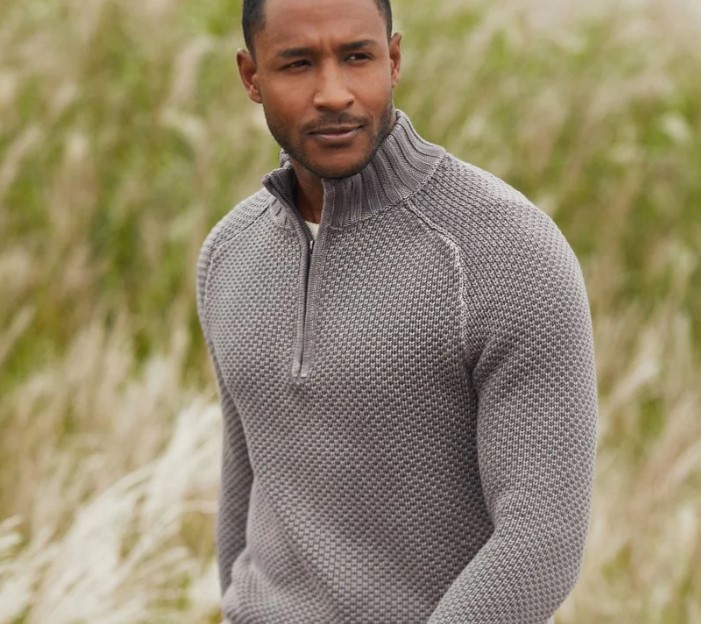
The right sweater is the stylish man’s Swiss Army Knife. It is a simple garment that can do almost anything. It can be a layering piece under a vest and a coat. It can be a middle piece over a dress shirt and tie and under a sport coat. Or it can be the main piece in an ensemble made for work or play. The important thing to remember is there is never a situation where the right sweater isn’t appropriate. Now, if you have been with us for a while, you know what is coming. It isn’t as simple as running out and buying a sweater. There are different silhouettes, different fabrics, and different price points. But here, we will help you figure out what to get.
Like so many things in life, in sweaters, you usually do get what you pay for. That is not to say that sometimes expensive designer merchandise isn’t made from cheap materials, and what you’re really paying for is a few square inches of logo-embroidered label. Conversely, a store will sometimes sell a well-made sweater of quality yarns as a “loss-leader,” hoping to tempt you into the department to splurge on other things. Before you buy a sweater, turn it inside out: are the seams straight and bound properly, so they won’t come apart easily after a few wears? Does the zipper feel like it could catch easily on the sweater itself? Are the buttons sewn on securely? Beyond that, buy the best you can afford, and hold onto your receipts.

Exactly what is a sweater?
There are plenty of people who will generalize the term, implying that a sweater (Or a jumper if you are from across the pond or down under) is just about anything that you pull on that’s not a shirt and isn’t a jacket. Sorry, but we’re too old school for that. Sweatshirts? No. Not a sweater. Anything Polartec or other branded fleece product? Hmmm. Uh, yeah, but not really.
We consider a sweater to be any top that is produced by a knit or crochet method where you can really see the yarns that make up its structure. It can be a pullover or open in the front with buttons or zippers. Those yarns can be made of, really, just about anything (we had a dorm buddy in college who knit a whole sweater from packaging string), but here are a few more common materials.

Common fabrics of sweaters
Without diving too deeply into technical specifications, just keep in mind the following: Natural fibers, like wool or cotton, are more expensive than man-made fibers like acrylic, and they also usually hold up better. They also breathe better, so they are easier to wear in the transition months of the year. So keep that in mind when you are searching for the right sweater; the fabric can make a huge difference. Here are some of the most common sweater fabrics.
- Wool Sweater: Generally speaking, wool is the hair gathered from sheep and goats, but it can also include that of rabbits, camels, alpacas, llamas, and vicunas. Basically, look for an animal that can keep itself warm under extreme conditions: Someone makes wool from it.
- Merino Sweater: Made from the wool of merino sheep, merino is commonly used for extremely finely knit sweaters that border on (or can actually be) merino t-shirts.
- Cashmere Sweater: A super-soft yarn that’s sheared from goats in Mongolia, it’s the very definition of luxury.
- Cotton Sweater: From the cotton plant, it’s usually used for lighter-weight, cooler sweaters that are more appropriate for late spring or early summer layers. It’s sometimes blended with linen or hemp to add texture and luster.
- Silk Sweater: Spun by moths whose cocoons are sacrificed to create opulent fabrics, silk sweaters are not very common. They tend to lose their shape easily, so they are often blended with other materials like cotton or wool. They can be, however, very warm and comfortable yet elegant and colorful.
- Acrylic Sweater: A man-made fiber, acrylic is great to help sweaters hold their shape. It’s also pretty easy to care for and is a great value. It does tend to pill after only a few wearings, particularly where there is any kind of regular friction, like where the arms brush against the body.
- Spandex or Elastane Sweater: A stretch fiber. Usually, just a bit blended into a sweater makes it that much easier to pull on and off while also offering ease of movement.

Sweater silhouettes you need in your closet
The Turtleneck: The Normal Brand Seawool Nep
If you are looking for a sophisticated look that never goes out of style, the turtleneck is the choice for you. Great under a suit or a jacket and the perfect base layer under snow gear, this Seawool option from The Normal Brand will keep you warm and stylish.

The Crewneck: Ash & Erie Knit
The crewneck is the most basic option for a sweater. With its normal rounded color and no-frills design, it will be your most versatile companion in the winter months. This basic knit from Ash & Erie will do nicely in your closet.

Fisherman: Aran Sweater Market ClanAran Fisherman
Many of the sweaters we see today can trace their history back to the Isles of the UK where they were designed as cold-weather gear for the fisherman of the time. Known for their thick fabric and chunky collars, these are the warmest you will find in your closet, and Aran Sweater Market has been doing these right longer than the US has been an independent nation.

Cardigan: Dandy Del Mar Castello Cardigan
You may remember seeing Mr. Rogers coming in from work and changing from his work jacket to a comfortable cardigan as a signal that he is now home, but that is no longer the image of cardigans as they are now one of the most common sweaters for men. Taking the place of a sport coat or a light jacket, these are the perfect accessory to your look. This striking piece from Dandy Del Mar helps put a little vintage nostalgia in your wardrobe.

Shawl Collar: &SONS Port Shawl
Speaking of vintage nostalgia, sometimes it feels like men aren’t the same as they used to be. You can change that feeling by donning the look of the old school, tough-as-nails dockworker shawl collar from &SONS, who specializes in some of the manliest throwbacks you’ll ever find.

The 1/4-Zip: Overland Levi Cotton Sweater
The primary job of a sweater is to keep you warm, and nobody knows how to stay warm better than the King of the Ski Towns here in the States. Overland Sheepskin Co. continues to excel at keeping us warm and stylish with this simple throw-it-on and-go option.

The Hoodie: Aether Sierra Hooded Sweater
Speaking of staying warm, Aether is the “Uniform of the Restless” that summit some of the toughest peaks in the world. And they are trusted by mountaineers and extreme sports nuts who strap boards to their feet and speed down mountains. So you better believe that they can be counted on to keep you warm and stylish with this hoodie.

The Military: N. Peal London 007 Ribbed Army Sweater
The weather doesn’t care when men go to war. Sometimes men have to take to the battlefield in the cold, and so the military sweater was born. This striking piece by N. Peal London is so stylish and versatile that it was the choice for 007, James Bond, himself in his latest film, No Time to Die.

The Cable Sweater: Highland Duds Breckenridge
Highland Duds makes it easy to shop by putting together “stacks.” Which are three-piece collections for any occasion. One of their add-on pieces that can complement any stack you choose is this cable knit sweater. These sweaters are so cool that even a raggedy one worn by Chris Evans in Knives Out took the sartorial world by storm.

The V-Neck: Y. Chroma Dwayne V-Neck
Life doesn’t end at 40. Hell, it is just beginning. And nothing beats a new start with a new grip on life. Max Israel of Y. Chroma believes that you are just closing the door on the first act of your three-act life at 40 years old. And why not add a little color as you lean into act two? This vibrant V-neck will bring a new bright outlook to your newfound colorful life.

The Roll Collar: Ministry of Supply Waffle Knit Roll Neck
There is so much about this sweater to look at it is almost hard to describe. The waffle knit pattern gives the striking indigo color a depth that makes you stand out in a crowd. The roll-neck collar gives you a little throwback to the fisherman of the past. And the MIT-backed design process gives you a glimpse into the future of your closet. Ministry of Supply knows how to keep you looking and feeling your best in a sweater.

The Cashmere: Mott & Bow Cashmere Bergen
When you are wearing cashmere, there is no reason to go crazy. You don’t need a lot of color, you don’t need a lot of flair. The fabric speaks for itself. This simple cashmere crewneck from Mott & Bow should be in your closet. It is a staple of any man’s wardrobe.

The Alpaca: Paka Original Crew
We’re not going to lie, we love a good head-to-head match up. And in the battle of softness, we would love to see people argue over which one wins, the cashmere above, or this alpaca wool selection from Paka. Hailing from the Andes, this sky-blue number will keep your style on the lips of everyone around you, all while you’re lost in the bliss of its cloud-like embrace.

How to care for a sweater
If you’ve made an investment in a new sweater, you’ll want to take good care of it. Here are a few simple rules.
- You probably won’t need to wash a sweater very often. Hang it over the back of an upholstered chair or an otherwise flat surface and let it air out overnight.
- If something should happen, most sweaters can be hand-washed in a basin with a mild soap (dish detergent usually works best). Carefully but thoroughly rinse out the soap. Some can even be washed in the washer on a gentle setting (read the care instructions). Allow it to air-dry on a thick towel on a flat surface. You may need to gently block or push the fabric back into the original shape. When in doubt, take it to a professional dry cleaner.
- Do not hang sweaters on a hanger of any sort. The fabric will stretch, and the hanger will leave an imprint in the shoulders. You’ll end up looking like your own shoulders are growing horns.
- Store sweaters by folding them in thirds lengthwise, folding the arms along the sides to form a neat rectangle. Fold the rectangle in half.
- Place the sweater on a shelf or in a drawer. Off-season, place clean sweaters in a box (not airtight) and store them in a cool, dry place away from sunlight.
Now you are armed with all you need to help you find the best sweater. Whether or not it is the best sweater on the market isn’t the question. The most important part of this is discovering which is the right sweater for you.



